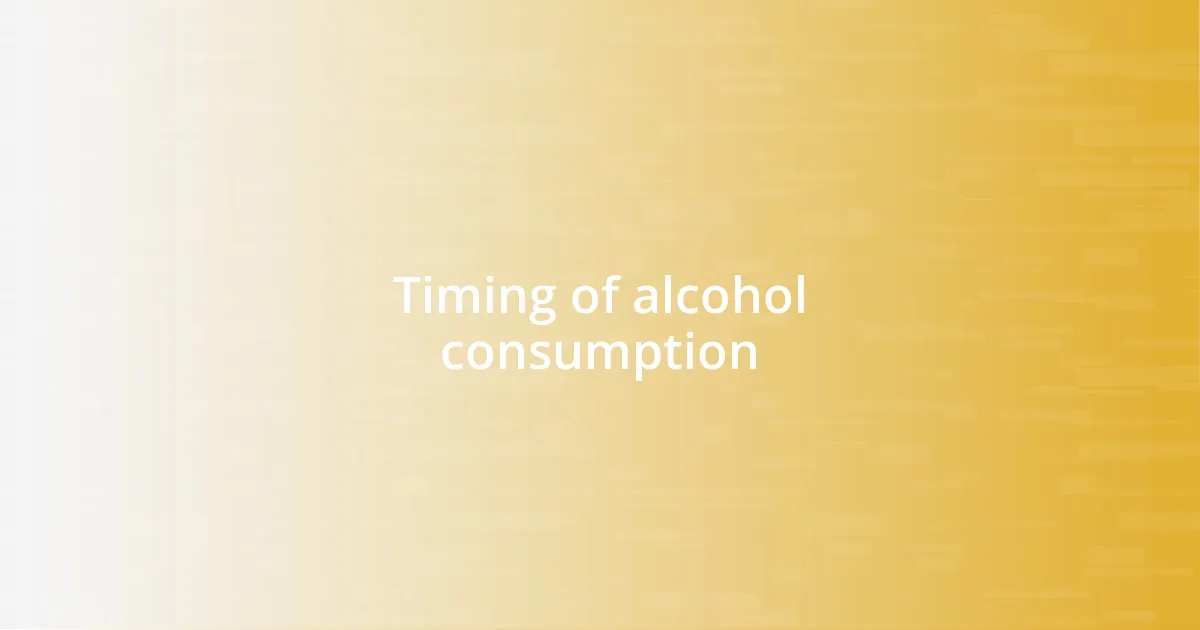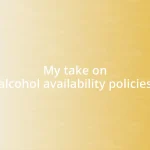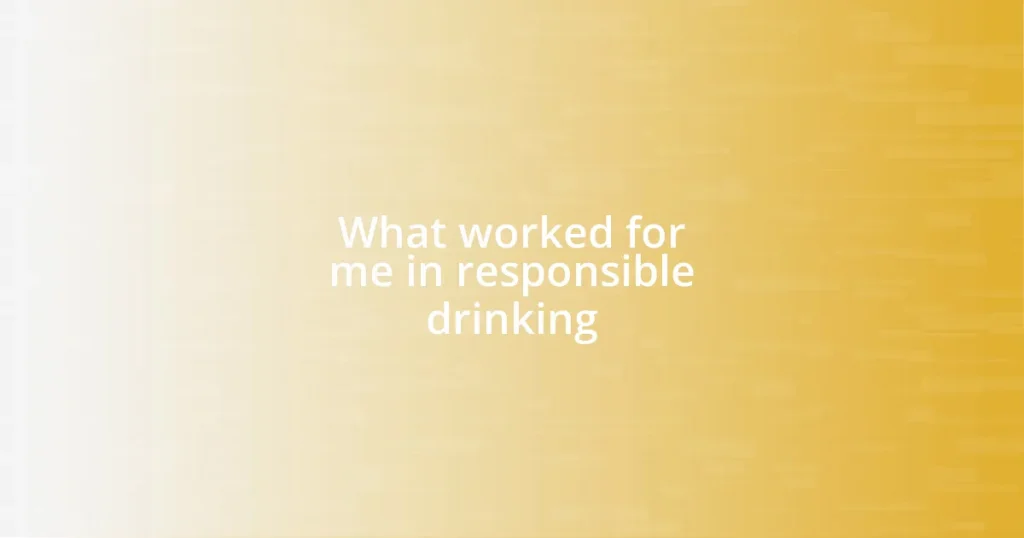Key takeaways:
- Set realistic fitness goals by starting with smaller, attainable milestones and focusing on meaningful objectives rather than arbitrary targets.
- Make informed drink choices to balance enjoyment and health, opting for lighter alternatives and tracking consumption.
- Establish drink limits ahead of social events to enjoy without compromising fitness goals, and incorporate active outings into drinking plans.
- Monitor progress to understand the impact of alcohol on fitness, adjusting habits based on personal observations and experiences.

Setting realistic fitness goals
When it comes to setting fitness goals, it’s essential to be honest with yourself about what you can realistically achieve. I remember the first time I decided to train for a marathon; my initial excitement had me envisioning crossing the finish line in record time. However, I quickly learned that my body wasn’t quite ready for such an ambitious target. So, why not start with smaller, attainable milestones? Gradually increasing my running distance not only built my confidence but also allowed me to enjoy the process more.
Sometimes, I ask myself, “What do I genuinely want out of my fitness journey?” Answering this helped me focus my efforts on meaningful goals rather than chasing arbitrary numbers. For instance, instead of fixating on losing a set amount of weight, I shifted my aim towards improving my stamina and strength. This, in turn, contributed to a more sustainable and enjoyable routine.
It can be tempting to compare your goals to those of others, but that’s not the way to go. Each person’s journey is unique. I’ve had days when I felt discouraged, watching someone effortlessly crush their workouts. Yet, I learned to appreciate my progress and understand that real change takes time, patience, and a sprinkle of kindness towards myself. Isn’t it much more rewarding to celebrate every small victory instead of fixating on perfect outcomes?

Choosing the right drinks
Choosing the right drinks can significantly impact both your fitness journey and your enjoyment of social occasions. I remember my first few tours at happy hours, where peer pressure made me gravitate towards sugary cocktails. Those drinks were delightful at the moment, but I often found myself regretting my choices the next day, physically feeling the effects during my next workout. By being mindful of what I consumed, I learned to opt for lighter alternatives, such as wine or spirits mixed with soda water, which helped me enjoy the social aspect without compromising my fitness goals.
It’s essential to consider not just the calories in a beverage, but also how specific drinks might affect your performance. For example, I experimented with different post-workout drinks. Some days I’d sip on coconut water for hydration, while on others, a protein shake seemed more enticing. Over time, I realized that while both options had their merits, just being aware of how different drinks interacted with my body led to better recovery and overall fitness.
Making informed choices became empowering for me. I started keeping a small guide of my favorite drink options that balanced enjoyment and my health goals. Below is a simple comparison of popular drinks in terms of calories and sugar content, which can help you navigate the choices at the bar or any social gathering.
| Drink | Calories per Serving | Sugar Content (g) |
|---|---|---|
| Light Beer | 100 | 1 |
| Wine (5 oz) | 120 | 0.5 |
| Sweet Cocktail | 300 | 20 |
| Coconut Water | 45 | 6 |
| Soda Water + Spirit | 64 | 0 |

Establishing drink limits
Establishing drink limits became a game-changer in my fitness journey. I vividly remember the first time I set a limit for myself at a gathering. It felt liberating to enjoy the evening without the pressure of overindulging. By determining a specific number of drinks ahead of time, I found I could still join in on the fun without sacrificing my progress. It’s all about making mindful choices that align with your goals.
To help you on your way to establishing your own drink limits, here are some tips I’ve found useful:
- Set Clear Boundaries: Decide in advance how many drinks you’ll have before the event starts.
- Track Your Consumption: Use a note on your phone or a simple tally system to keep track of your drinks throughout the night.
- Alternate with Water: For every alcoholic beverage, have a glass of water. Not only does this help with hydration, but it also slows down your drinking pace.
- Choose Quality Over Quantity: Instead of tasting everything, select one or two drinks that you genuinely enjoy.
- Plan Your Fitness Schedule: Consider your workout plans for the following day and adjust your drinking accordingly. It’s easier to say no when you know you’ll be running that morning.
By implementing these strategies, I discovered a balance that kept my lifestyle enjoyable yet conducive to my fitness goals. Each social event felt more relaxed, allowing me to fully engage with friends while staying true to my health aspirations.

Timing of alcohol consumption
I’ve found that the timing of alcohol consumption can make a huge difference in how I feel the next day. For instance, I remember a few evenings where I chose to sip on a drink right before hitting the gym. I thought it wouldn’t affect me much, but the next morning, my workout felt sluggish, and it was tough to push through those last few sets. It got me thinking about how my body needs time to process the alcohol, and it often takes longer than I realize.
Now, I try to enjoy my drinks earlier in the evening. By finishing up a couple of hours before bed, I can go to sleep without the heavy sensation of alcohol lingering. When I wake up, I feel fresher and more energized, ready to tackle my morning routine. Have you ever noticed how your body reacts differently based on when you drink? It’s like listening to my body has become a key part of my fitness journey.
I often suggest to friends that if they plan a big workout the next day, they might want to skip the late-night cocktails altogether. Just the other weekend, I chose sparkling water after dinner instead of a cocktail, and I felt sharp during my morning run. Balancing enjoying a night out while preparing my body for the next day’s challenges has been quite the revelation!

Incorporating fitness into drinking plans
I’ve found that planning fitness activities around social events can truly enhance the experience. For instance, when I hosted a gathering a few months ago, I organized a fun group workout beforehand. Everyone arrived energized and ready to celebrate afterward, and it felt great to enjoy drinks together knowing we had just accomplished something as a team. Have you ever considered how integrating fitness can create a deeper bond with friends during a night out?
Another strategy I regularly use is to schedule post-drink workouts. I recall one Friday night where I had a few drinks with friends, but instead of crashing on the couch, I convinced myself to hit the gym early the next morning. That choice transformed my Saturday—sweating out the extra drinks felt rejuvenating, and the endorphins totally outweighed the lingering effects of the night before. How do you feel when you fit in a workout the day after a night out?
Lastly, I try to incorporate active outings into my drinking plans. A couple of weeks ago, a friend and I decided to check out a local beer garden, but we cycled to get there instead of driving. It felt fantastic to enjoy a few drinks while also squeezing in a workout. That balance between fitness and social moments not only made the evening enjoyable, but it also fostered a sense of accomplishment. Isn’t it amazing how you can elevate fun moments by weaving in a bit of activity?

Monitoring progress and adjusting
Monitoring my progress has become instrumental in understanding how drinking and fitness coexist in my life. I remember the first time I started tracking my workouts alongside my alcohol intake; it was eye-opening. I jotted down how I felt during workouts after nights out and compared them to days when I abstained. The results were stark. It sparked a realization: I need to adjust my habits based on how my body responds.
As I continued this journey, I began setting specific goals. Did I want to maintain my energy levels during workouts, or was indulging in a few drinks worth sacrificing a potential PR? I distinctly recall a weekend where I felt particularly sluggish after a few too many drinks. That’s when I decided I would limit myself to just one drink on workout days moving forward. It’s fascinating how even small tweaks like this can lead to noticeable improvements. Have you ever adjusted your routine based on your observations of how you feel?
To ensure I’m on the right track, I also reflect weekly on both my fitness achievements and any challenging drinking moments. Some weeks, I’m proud of my progress, while others remind me to be more mindful. Just last month, I noted a dip in my endurance; this prompted me to experiment with cutting back on alcohol for a few weeks. The boost in my stamina was a pleasant surprise. Isn’t it interesting how self-monitoring often encourages growth and better choices?















